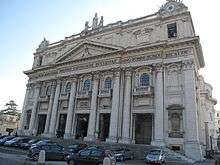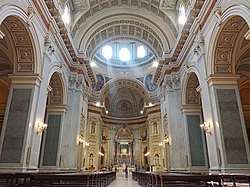Madre del Buon Consiglio
The Madre del Buon Consiglio (or Basilica dell'Incoronata Madre del Buon Consiglio or Maria del Buon Consiglio) (Italian: Crowned Mother of Good Counsel) is a Roman Catholic church in Naples, southern Italy. It is located on the hillside leading up to the Capodimonte palace and art museum and is visible from many quarters of the city.
| Basilica of the Crowned Mother of Good Counsel Basilica dell'Incoronata Madre del Buon Consiglio (in Italian) | |
|---|---|
 | |
| Religion | |
| Affiliation | Roman Catholic |
| Ecclesiastical or organizational status | Basilica |
| Year consecrated | 1960 |
| Status | Active |
| Location | |
| Location | Naples |
| Geographic coordinates | 40°51′52″N 14°14′49″E |
| Architecture | |
| Type | Basilica |
| Style | Renaissance and Baroque |
| Groundbreaking | 1920 |
| Completed | 1960 |

History
The church has its roots in two miracles observed by local girl Maria di Gesù Landi (21 January 1861 – 26 March 1931). Known for her devotion to Our Lady of Good Counsel (Madonna del Buon Consiglio), she created a painting of the saint in 1884, which apparently stopped an outbreak of cholera in the city in that year. 22 years later, the same painting appeared to clear the ash clouds from the 1906 eruption of Mount Vesuvius.
Vincenzo Vecchio designed the church in model of St. Peter's in Rome. The church was constructed between 1920 and 1940, on top of the ancient Catacombs of San Gennaro. It has become the destination of pilgrimages in the name of Maria di Gesù Landi. The church houses a number of works of art rescued from closed, damaged, or abandoned houses of worship in the city.
Legend has already attached itself to the church: the 1980 Irpinia earthquake toppled the head of the statue of the Madonna from the top of the church to the ground, where it crashed and lay inexplicably undamaged.
External links
| Wikimedia Commons has media related to Basilica dell'Incoronata Madre del Buon Consiglio (Naples). |
- Page at napoligrafia.it (in Italian)